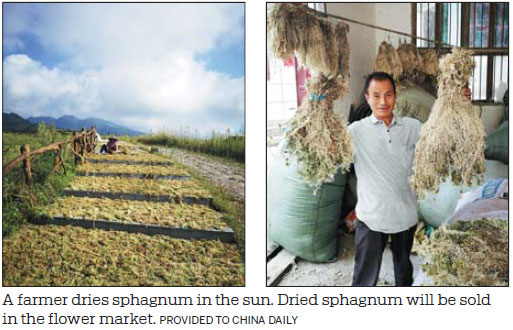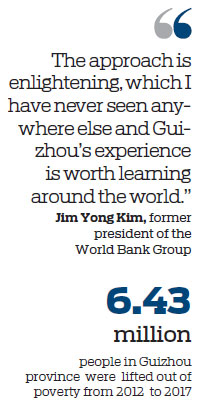
Government efforts to raise the living standards of poor people have focused on using modern agricultural techniques to kickstart China's vast rural economies
An agricultural revolution is pulling millions of people out of poverty in Southwest China's Guizhou province.
Long Jiayi, 33, is a beneficiary of the government campaign that encourages farmers to grow cash crops on the land they cultivated with traditional crops for generations.


Two years ago, with the support of the village's governing body, his family started to grow sphagnum, a kind of natural moss with a high economic value. It can be used in potted plants to replace the soil.
"We planted 11 mu (0.73 hectares) of sphagnum and can harvest nearly 3,000 kilograms in total, which can be sold for roughly 60,000 yuan ($8,961) a year," Long said.
Just a decade ago, his family grew corn and rice in their 0.27 hectares of land, which made just 3,000 yuan annually.
"My village is in the mountainous area and we have limited land. We had no choice at that time but to grow the crops, or let the land lie. Young people went outside to find jobs," Long recalled.
However, Zilinshan village, where Long lives, was suitable for sphagnum. This is due to the cool and humid weather, said Qu Jia, an officer with the National Forestry and Grassland Administration who led the poverty-relief mission there in August 2017.
"It's an ideal place for the growth of moss. The villagers just need to sow seeds, guarantee the water supply and sometimes weed. The mosses can grow very well," said Qu, adding that the villagers now have time to take temporary jobs in the town for extra money.
He also invited experts from the administration and universities to guide the farmers and raised funds to improve planting and processing skills and equipment.

Statistics show that 266.7 hectares of sphagnum was planted at Zilinshan village as of the beginning of 2019. It could make 12 million yuan a year, up 12.5 percent from a year ago.
Nearly 500 families, or 80 percent of village households, joined the program, which can earn them each more than 20,000 yuan annually. Some 307 people in 78 families in the village got out of poverty in 2018.
Over the years, Guizhou has been trying to lift people out of poverty by agricultural revolution, relocation and road building, as well as assistance and subsidies in education, medical care and housing.
"Our efforts aim to write a miraculous chapter in China's poverty-relief history and to provide a case study for the rest of the world," said Sun Zhigang, Party secretary of Guizhou.
The province's poor population was cut from 9.23 million in 2012 to 2.8 million in 2017. It was the biggest reduction in the country during that period, according to official figures.
Li Jian, deputy secretary-general of Guizhou provincial Party committee, director of the Poverty Alleviation and Development Office of Guizhou province and a deputy to the National People's Congress, said: "Our aim is to ease all the people and counties out of poverty by 2020. To solve regional poverty, basic principles include increasing their income, access to housing and clothing, as well as access to education and medical resources."
Sun reiterated the importance of the agricultural revolution, which will change the rural industry's structure and help farmers out of poverty.
Meng Pinghong, a researcher at the Guizhou Academy of Agricultural Sciences and a deputy to the National People's Congress, said Guizhou has little flat land.
"To make good use of agricultural resources, we have to change the traditional farming system, adjust planting structures and adopt multiple crops - to increase farmers' income by improving efficiency and economic benefits of the land."
The government will help farmers to choose the right sector - vegetables, tea, poultry, fungi, herbs and other economic crops - to replace traditional corn and rice, and help them acquire techniques, funds, management and marketing skills.
Another program is to relocate people from areas unsuitable for living. Villages with fewer than 50 households and 50 percent of its population in poverty are moved to new government-built residential areas.
The government designs the residential areas to keep cultural characteristics and develop a local economy so residents have job opportunities.
Official figures show that about 500,000 relocated people were employed or started their own business - on average 1.78 persons in every household - in 2018.
Started in 2016, it is expected that a total of 1.88 million people will be relocated by the end of June 2019, according to the government.
Hu Guozhen, vice-governor of the Qiandongnan Miao and Dong autonomous prefecture and a member of the standing committee of the 12th National Committee of the Chinese People's Political Consultative Conference, said relocation of families is an important method in poverty alleviation.
However, the limited time and various difficulties make it a challenge. It's important to help them live and work after relocation, Hu said.
"To guarantee their livelihood, industries should be developed and a long-term mechanism should be taken into consideration."
Sun said that 2019 is a critical year to beat poverty.
He noted that more resources will be allocated to the most impoverished villages to fulfill the target this year.
Jim Yong Kim, former president of the World Bank Group, spoke highly of Guizhou's mode of developing the e-commerce to promote production and expand local markets in rural areas.
"The approach is enlightening, which I have never seen anywhere else and Guizhou's experience is worth learning around the world," he said.
Li Hanyi contributed to this story.
chenhong@chinadaily.com.cn
(China Daily 03/07/2019 page20)